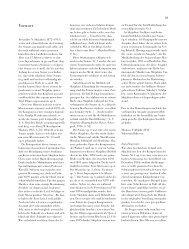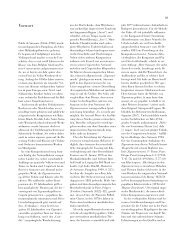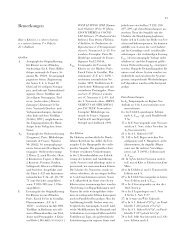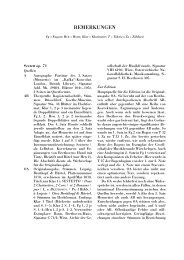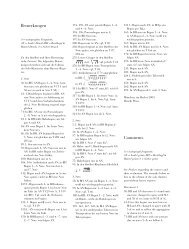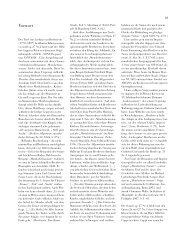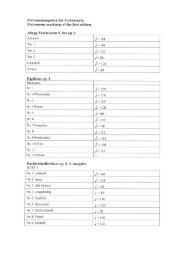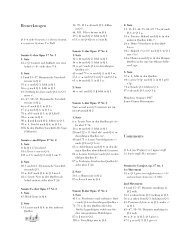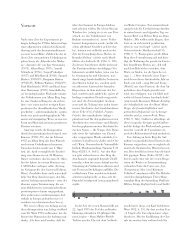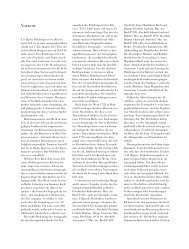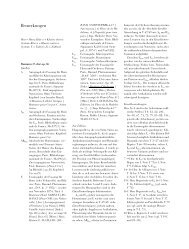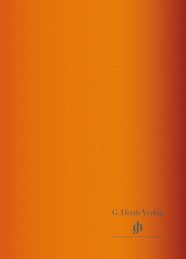PDF, 116 KB - Henle Verlag
PDF, 116 KB - Henle Verlag
PDF, 116 KB - Henle Verlag
You also want an ePaper? Increase the reach of your titles
YUMPU automatically turns print PDFs into web optimized ePapers that Google loves.
VI<br />
Vorwort<br />
Den auf der vorigen Seite wiedergegebenen<br />
Titel stellte Bach 1723 seiner Reinschrift<br />
jener zwei- und dreistimmigen<br />
Übungsstücke voran, die er in den vorhergehenden<br />
Jahren für den Klavierunterricht<br />
geschrieben hatte, da er seine<br />
eigenen Söhne, voran den ältesten, Wilhelm<br />
Friedemann, in die Lehre nahm.<br />
Dass hier ein Musikerzieher nicht nur<br />
mit überragendem Kunstverstand und<br />
schöpferischem Vermögen, sondern<br />
auch mit besonderem Verantwortungsgefühl<br />
des Herzens am Werke war, das<br />
hat diesen kleinen Stücken jene durch<br />
die Zeiten hindurch wirkende Kraft gegeben,<br />
die sie noch heute zu einem<br />
Grundwerk der Musikerziehung am<br />
Klavier macht und darüber hinaus zu<br />
wahrer Gemütsergötzung für alle, die<br />
Ohren haben zu hören.<br />
Die früheste erhaltene Niederschrift<br />
des Werkes, zumeist von Bachs eigener<br />
Hand, findet sich in dem am 22. Januar<br />
1720 begonnenen Clavierbüchlein vor<br />
Wilhelm Friedemann Bach. Hier sind<br />
die zweistimmigen Stücke Praeambulum,<br />
die dreistimmigen Fantasia genannt.<br />
Was ihm hier noch nicht ganz gelungen<br />
schien, bringt dann die Reinschrift<br />
1723 in ausgereifter Form. Auch<br />
die Namen sind geändert: die zweistimmigen<br />
Stücke nennt Bach nun Inventio,<br />
die dreistimmigen Sinfonia – erst später<br />
hat sich’s eingebürgert, auch die dreistimmigen<br />
Inventionen zu nennen. Was<br />
der Reinschrift in Bachs weiterer Unterrichtstätigkeit<br />
überdies zugefügt wurde,<br />
sind lediglich Auszierungszeichen, wie<br />
auch die aus Bachs Schülerkreis erhaltenen<br />
Abschriften über den in Bachs ursprünglichen<br />
Niederschriften äußerst<br />
sparsamen Gebrauch solcher Zeichen<br />
meist im Anschluss an jene Nachträge in<br />
der Reinschrift hinausgehen.<br />
Man hat mitunter gemeint, bei diesen<br />
Auszierungen handle sich’s doch nur um<br />
Flitterwerk, das dazumal wohl Mode gewesen,<br />
doch im Grunde unbachisch sei;<br />
man brauche sich also um diese „Manieren“<br />
nicht zu kümmern. Aber sie waren,<br />
recht verstanden, auch für Bach etwas<br />
musikalisch Notwendiges, nicht nur<br />
„bunte Noten“, sondern „redende Klänge“,<br />
nicht nur äußerlicher Aufputz, sondern<br />
Ausdruck inwendiger melodischer<br />
Feinbewegtheit. Mit Worten Carl Philipp<br />
Emanuel Bachs: sie sind „unentbehrlich“,<br />
denn „sie hängen die Noten zusammen,<br />
sie beleben sie, … sie helfen<br />
ihren Inhalt erklären, sie geben einen<br />
ansehnlichen Teil der Gelegenheit und<br />
Materie zum wahren Vortrage“, das<br />
heißt eben zum „manierlichen“, kantablen<br />
Vortrage, und Bach will ja mit diesen<br />
Lehrstücken, wie er im Titel ausdrücklich<br />
sagt, „am allermeisten“ dazu<br />
anleiten, „eine kantable Art im Spielen<br />
zu erlangen“.<br />
Sollte nun solche „auffrichtige Anleitung“<br />
darin bestehen, dass man dem<br />
Schüler mit kleinen Noten und Zeichen<br />
alles vormacht, was er dann nur nachzumachen<br />
braucht? Solche „Affenmethode“<br />
wollen wir Bach denn doch nicht<br />
zutrauen! Sie wäre auch völlig gegen<br />
den Sinn solchen Auszierens, das eben<br />
nicht musikalisch-passives, nur fingertechnisch<br />
aktives Abspielen ist, sondern<br />
musikalisch-aktives Erspüren und Ausgestalten<br />
der in gewissen Melodietönen<br />
lebendigen Bewegtheit, die in taktfesten<br />
Noten gar nicht recht zu fassen wäre.<br />
Daher hat sich Bach gerade auch in den<br />
Stücken, deren kantabler Gehalt ganz<br />
besonders nach „manierlicher“ Auszierung<br />
drängte, mit Auszierungsvorschriften<br />
äußerst zurückgehalten – so in der<br />
Es-dur- und der e-moll-Sinfonie. Gerade<br />
das waren ja für die Lehrbegierigen<br />
Hauptprobestücke, an denen sie durch<br />
eigene Versuche lernen konnten, die<br />
Klänge singen und reden zu lassen.<br />
Die vorliegende Ausgabe hält sich<br />
demnach an Bachs Reinschrift von<br />
1723. Sie darf aber auch die darin<br />
nachgetragenen Zeichen sowie die in<br />
Friedemanns Clavierbüchlein nicht beiseite<br />
lassen. Dementsprechend sind jene<br />
wenigen, mit denen sich Bach in der<br />
Reinschrift ursprünglich begnügte, in<br />
gewöhnlichem Druck wiedergegeben,<br />
die darüber hinaus im Clavierbüchlein<br />
gesetzten sowie die in der Reinschrift<br />
später zugefügten in Kleindruck; besonders<br />
beachtenswerte Zeichen aus anderen<br />
Schülerabschriften sind klein und in<br />
Klammern gesetzt.<br />
Der Spieler möge auch die Ausführung<br />
der kleinen Zeichen im Zusammenhang<br />
der Melodie eindringlich studieren,<br />
um das Feingefühl für notwendiges<br />
und sinnvolles Auszieren auch an<br />
solchen Stellen zu gewinnen, wo die alten<br />
Handschriften keine Zeichen setzen.<br />
Bachs Musik wird ihm dabei nur umso<br />
lebendiger werden.<br />
Als Anleitung diene die unten abgebildete<br />
von Bach selbst dem Clavierbüchlein<br />
vorgesetzte „Explication unterschiedlicher<br />
Zeichen, so gewisse Manieren<br />
artig zu spielen andeuten“.
VII<br />
Bach braucht hier die französischen<br />
Bezeichnungen cadence und accent an<br />
Stelle der deutschen Doppelschlag und<br />
Vorschlag. Ergänzend ist zu sagen, dass<br />
er statt jenes Trillerzeichens oft den<br />
Buchstaben t oder tr setzt und statt des<br />
Vorschlagzeichens die je nach ihrer melodischen<br />
Aufgabe kürzer oder länger<br />
auszuführende Vorhaltnote selbst als<br />
kleines Achtel. Nicht aufgezeichnet sind<br />
hier der Schleifer, ein durch ein Trillerzeichen<br />
mit aufwärts geschwungenem<br />
Endstrich gefordertes schnelles, stufenmäßiges<br />
Aufsteigen vom Ort des Zeichens<br />
in den Hauptton, und die Acciaccatura,<br />
ein durch einen Schrägstrich unter<br />
der Note angedeutetes kurzes Anschlagen<br />
des tieferen Nachbartons<br />
gleichzeitig mit oder vor dem Hauptton.<br />
Voraussetzung eines im Sinne Bachs<br />
„manierlichen“ kantablen Vortrags ist<br />
allerdings, dass man seine Musik nicht in<br />
starr akzentuierter, sondern in lebendig<br />
fließender rhythmischer Taktbewegung<br />
empfindet und auch im Klang nicht starr<br />
und gleichförmig, sondern lebensvoll gegliedert<br />
und artikuliert; wie ja Bach<br />
selbst bezeugtermaßen „so viele Mannigfaltigkeit<br />
in seinen Vortrag zu bringen<br />
wusste, dass jedes Stück unter seiner<br />
Hand gleichsam wie eine Rede sprach“.<br />
Hat er doch diese Stücke für das Klavichord,<br />
das alte deutsche Hausklavier geschrieben,<br />
das er seines mannigfach<br />
schattierungsfähigen Tones wegen als<br />
„das beste Instrument zum Studieren sowie<br />
überhaupt zur musikalischen Privatunterhaltung“<br />
besonders liebte.<br />
Der Reinschrift Bachs folgt diese Ausgabe<br />
auch in der Verteilung der Stimmen<br />
auf beide Systeme: in den zweistimmigen<br />
Inventionen hat jede Stimme<br />
ihr eigenes System, in den dreistimmigen<br />
wechselt die Mittelstimme je nach<br />
ihrer Höhenlage das System, ohne<br />
Rücksicht darauf, ob sie von der Rechten<br />
oder der Linken mitzugreifen ist.<br />
Dem heutigen Brauch angeglichen wurden<br />
lediglich die Versetzungszeichen<br />
und die von Bach im Altschlüssel notierten<br />
Stellen. Besonderheiten sind in Anmerkungen<br />
erörtert (siehe Bemerkungen<br />
am Ende des Bandes).<br />
Erlangen, Frühjahr 1970<br />
Rudolf Steglich<br />
Zur revidierten Ausgabe<br />
Rudolf Steglich, der 1976 verstorben<br />
ist, hat die Revision seiner Ausgabe<br />
nicht mehr selbst vornehmen können.<br />
Für die neue Ausgabe wurden die Quellen<br />
noch einmal verglichen. Einige Verbesserungen<br />
wurden vorgenommen und<br />
Inkonsequenzen im Notentext, besonders<br />
die Artikulation betreffend, beseitigt.<br />
In die Bemerkungen wurden die Ergebnisse<br />
neuerer Quellenforschung eingearbeitet.<br />
Duisburg, Sommer 1978<br />
G. <strong>Henle</strong> <strong>Verlag</strong><br />
Preface<br />
The title on page V is that placed by<br />
Johann Sebastian Bach in 1723 at the<br />
head of his fair copy of those two and<br />
three part keyboard studies that he had<br />
written in preceding years for teaching<br />
purposes, having undertaken the musical<br />
instruction of his own sons, particularly<br />
the eldest, Wilhelm Friedemann.<br />
That these little pieces were the work of<br />
a musical pedagogue possessing not only<br />
creative gifts and a consummate knowledge<br />
of art but also a deep sense of artistic<br />
responsibility has lent them that potency<br />
throughout the ages that makes<br />
them even today a groundwork of piano<br />
teaching and a real pleasure and delight<br />
for all those, who have ears to hear.<br />
The earliest extant copy of the work,<br />
largely in Bach’s own hand, is found in<br />
the Clavierbüchlein for Wilhelm Friedemann<br />
Bach begun on Jan. 22, 1720.<br />
This contains the two-part pieces Praeambulum<br />
and the three-part called Fantasia.<br />
The things that did not seem quite<br />
right to him as yet are found in finished<br />
form in the fair copy of 1723. The titles<br />
have also been changed. Bach now calls<br />
the two-part works Inventio, the threepart<br />
Sinfonia. The latter only came to be<br />
known as Inventions later on. The only<br />
other additions to the fair copy during<br />
Bach’s further teaching activities were<br />
ornaments. Those in the copies by<br />
Bach’s pupils in excess of Bach’s extremely<br />
rare use of such signs in his<br />
original manuscripts are also largely<br />
based on these additions to the fair<br />
copy.<br />
For all that, it was thought now and<br />
then that these ornaments were merely<br />
gew gaw, which to be sure was the fashion<br />
at that time, but after all is alien to<br />
Bach. Therefore one did not need to<br />
bother with these ornaments. But it<br />
should be clearly understood that they<br />
were musically necessary even for Bach<br />
– they were not only “decorative notes”<br />
but “expressive sounds”. In the words<br />
of Carl Philipp Emanuel Bach, they are<br />
“indispensable” since they “connect the<br />
notes, enliven them … help explain their<br />
content, provide a considerable part of<br />
the occasion and material for a correct<br />
manner of performance”, i. e. for an<br />
“ornamented” cantabile performance;<br />
and with these little studies Bach expressly<br />
wishes (as he says distinctly in<br />
the heading) to “show above all how to<br />
acquire a cantabile style in playing”.<br />
But should such an “honest method<br />
of instruction” consist in showing the<br />
student, by means of small notes and<br />
signs, exactly what to do so that now he<br />
only needs to imitate it? Surely we cannot<br />
think Bach guilty of such an “apish<br />
method”! It would also be entirely contrary<br />
to the sense of such ornamentation,<br />
which most certainly is not a musically-passive<br />
playing – active only in the<br />
sense of finger dexterity – but a musically-active<br />
sensing and shaping of the vigorous<br />
emotion inherent in certain melodic<br />
notes, which could not be properly<br />
expressed in notes in strict rhythm.<br />
Therefore in just those pieces where the<br />
cantabile content distinctly cries out for<br />
ornament, Bach was extremely chary of<br />
his embellishments, as in the E flat major<br />
and the e minor Sinfonie. These were<br />
the principal test pieces for “those desirous<br />
of learning”, with which they could<br />
experiment and learn how to make the<br />
notes “sing and talk”.
VIII<br />
Accordingly the present edition follows<br />
Bach’s fair copy of 1723. But it<br />
cannot disregard the signs that were<br />
subsequently added, nor those in Friedemann<br />
Bach’s Clavierbüchlein. Therefore<br />
those few signs that Bach was originally<br />
content to indicate in the fair copy<br />
are given in ordinary notation, those<br />
from the Clavierbuchlein as well as<br />
those added later to the fair copy, in<br />
small notation. Those taken from the<br />
copies of other Bach pupils that are especially<br />
worthy of notice are given in<br />
small notation in brackets.<br />
The performer should also study<br />
thoroughly the execution of the small<br />
signs in relationship with the melody so<br />
as to acquire a sensitive feeling for necessary<br />
and meaningful embellishment<br />
even in those passages where no ornaments<br />
are indicated in the old manuscripts.<br />
In this way Bach’s music will become<br />
all the more alive for him.<br />
The “Explanation of Different Signs,<br />
showing the correct manner of playing<br />
certain Ornaments”, with which Bach<br />
himself prefaced the Clavierbüchlein<br />
may serve as guide (see p. VI).<br />
Here Bach uses the French terms cadence<br />
and accent instead of the German<br />
Doppelschlag and Vorschlag. It should<br />
also be mentioned that instead of the<br />
trill sign, he often employs the letters<br />
t or tr and instead of the appoggiatura<br />
sign writes a small eighth-note, which is<br />
to be played either long or short according<br />
to its melodic task. Not indicated<br />
here are the slide, represented by a trill<br />
sign with rising stroke at the end, indicating<br />
that the main note is to be approached<br />
rapidly stepwise from the interval<br />
of a third below; and the acciaccatura,<br />
represented by a diagonal dash<br />
under the note, indicating that the lower<br />
neighbour note is to be struck quickly<br />
before, or simultaneously with, the main<br />
note.<br />
A prerequisite to an “ornamented”<br />
cantabile performance in Bach’s sense<br />
is, of course, that his music be taken not<br />
in a rigorously accented, but a lively,<br />
flowing rhythm. The tone should also<br />
not be stiff and uniform in quality, but<br />
organically constructed and articulated,<br />
mobile, full of life; just as Bach himself,<br />
as amply testified, “knew how to give<br />
such variety to his playing that in his<br />
hands every piece was as eloquent as<br />
speech”. For he wrote them for the clavichord,<br />
the old-fashioned German<br />
“house clavier”, which he considered<br />
“the best instrument for study as, in<br />
general, for private musical entertainment”,<br />
and one of which he was especially<br />
fond because of its variety in gradations<br />
of tone.<br />
This edition also follows Bach’s fair<br />
copy in the division of the parts on the<br />
two staves. In the two-part inventions<br />
each part has its own staff. In the threepart<br />
inventions the middle voice changes<br />
staff according to its pitch, irrespective<br />
of whether it is to be played with<br />
the right or the left hand. Only the accidentals<br />
and the passages notated by<br />
Bach in the C clef have been modernized,<br />
to conform to present usage. Special<br />
points are discussed in the accompanying<br />
notes (see Comments at the end<br />
of this volume).<br />
Erlangen, spring 1970<br />
Rudolf Steglich<br />
Note on the Revised Edition<br />
Rudolf Steglich, whose death occurred<br />
in 1976, was prevented from undertaking<br />
the revision of his edition. In preparing<br />
the new edition, the sources were<br />
compared once more. A number of improvements<br />
were introduced and inconsistencies<br />
rectified in the musical text,<br />
especially as regards phrasing. In the<br />
Comments, consideration has also gone<br />
to the results of more recent research into<br />
the sources.<br />
Duisburg, summer 1978<br />
G. <strong>Henle</strong> <strong>Verlag</strong><br />
Préface<br />
Le titre, reproduit à la page V, est celui<br />
que Bach, en 1723, place en tête de la<br />
copie au net de ses exercices à deux et<br />
trois voix. Il les avait écrits dans les années<br />
précédentes pour l’enseignement<br />
du clavier, ayant entrepris l’instruction<br />
musicale de ses fils et principalement de<br />
son aîné, Wilhelm Friedemann. C’est<br />
l’œuvre d’un pédagogue ne possédant<br />
pas seulement une excessive compréhension<br />
de l’art musical et un don créateur,<br />
mais qui a mis aussi tout son cœur<br />
dans l’œuvre à accomplir. C’est pour cela<br />
que ces petits morceaux ont gardé au<br />
cours des siècles tout le dynamisme que<br />
Bach y a mis et qu’ils servent encore<br />
aujourd’hui de base fondamentale à<br />
l’enseignement du piano, sans parler de<br />
la source inépuisable de joie qu’ils procurent<br />
à tous ceux qui savent écouter la<br />
musique.<br />
Le plus ancien spécimen que l’on a<br />
conservé de cette œuvre, en plus grande<br />
partie de la main de Bach, se trouve<br />
dans le Clavierbüchlein pour Wilhelm<br />
Friedemann Bach, commencé le 22 janvier<br />
1720. Les morceaux à deux voix y<br />
figurent sous le nom de Praeambulum et<br />
ceux à trois voix sous celui de Fantasia.<br />
Ce qui ne lui donne pas encore entière<br />
satisfaction sera remanié d’une façon<br />
plus perfectionnée dans la copie au net<br />
de 1723. Les noms y sont aussi changés:<br />
Bach appellera maintenant ces morceaux<br />
à deux voix Inventio, ceux à trois<br />
voix Sinfonia. Ce n’est que plus tard<br />
qu’on prit l’habitude d’appeler ceux à<br />
trois voix inventions. Ce qui fut ajouté à<br />
cette copie au cours de la carrière d’enseignement<br />
de Bach, ce ne sont que les<br />
signes d’ornements. Ceux-ci proviennent<br />
des copies d’élèves, dans ses manuscrits,<br />
Bach n’ayant employé ces signes<br />
qu’avec parcimonie. Ils sont tirés<br />
en grande partie des additions faites à la<br />
copie au net.<br />
On a parfois cru que ces ornements<br />
n’étaient que des enjolivures décoratives<br />
en vogue à cette époque, mais au fond<br />
ne répondant pas à la nature de Bach, et<br />
qu’il ne serait donc pas nécessaire de
IX<br />
s’occuper de ces «manières». Mais bien<br />
entendu, ils étaient pour Bach quelque<br />
chose de musicalement nécessaire, non<br />
pas un assortiment de notes, mais des<br />
sons expressifs; non pas un placage extérieur,<br />
mais bien une expression intérieure<br />
du ciselé mélodique. Pour employer<br />
les paroles de Carl Philipp Emanuel<br />
Bach: «ils sont indispensables, car<br />
ils unissent les notes entr’elles, ils les<br />
animent, … ils aident à en faire comprendre<br />
la teneur, ils indiquent, pour une<br />
bonne part, la matière et l’étoffe dont on<br />
doit se servir pour obtenir une bonne interprétation»,<br />
c’est-à-dire un bon cantabile.<br />
Dans ces morceaux destinés à l’enseignement,<br />
Bach veut «surtout montrer»,<br />
comme il l’exprime clairement<br />
dans son introduction, «comment on<br />
peut arriver à l’art du cantabile».<br />
Cette «véritable introduction» doitelle<br />
se contenter de montrer à l’élève par<br />
des notes et des signes rien que ce qu’il<br />
doit imiter? Nous ne voulons pas croire<br />
que Bach était capable d’employer une<br />
telle méthode! Elle serait en contradiction<br />
avec le sens de ces ornements qui ne<br />
sont pas musicalement passifs, autrement<br />
dit seulement actifs au point de<br />
vue des doigts, mais bien faits pour exprimer<br />
l’émotion vivante renfermée<br />
dans certaines notes de la mélodie et que<br />
les notes de valeur ne rendraient pas<br />
aussi bien. C’est pourquoi Bach a été<br />
très réservé quant aux prescriptions<br />
d’ornements, principalement dans les<br />
morceaux dont le caractère cantabile en<br />
demandait, comme par exemple dans la<br />
sinfonia en mi bémol majeur et en mi<br />
mineur. C’étaient des morceaux d’études<br />
par excellence où les élèves pouvaient<br />
apprendre par eux-même à faire<br />
chanter et parler les notes.<br />
La présente édition se conforme à la<br />
copie au net faite par Bach en 1723. Elle<br />
ne doit cependant pas exclure les signes<br />
qui y ont été ajoutés ultérieurement aussi<br />
bien que ceux du Clavierbüchlein de<br />
Friedemann Bach. Dans ce sens, les<br />
quelques signes dont Bach se contentait<br />
d’abord dans sa copie sont marqués en<br />
caractères ordinaires. Ceux qui ont été<br />
marqués en plus dans le Clavierbüchlein<br />
et ceux ajoutés plus tard à la copie sont<br />
rendus en petits caractères; ceux provenant<br />
des copies d’élèves ayant une valeur<br />
particulière sont rendus entre parenthèses<br />
et en petits caractères.<br />
L’exécutant devrait aussi étudier à<br />
fond l’exécution des petits signes en rapport<br />
avec la mélodie pour pourvoir acquérir<br />
le sentiment où la broderie ornementale<br />
devra être employée avec nécessité<br />
et compréhension, même aux endroits<br />
où les anciens manuscrits ne<br />
mettent pas de signes. La musique de<br />
Bach lui deviendra ainsi d’autant plus<br />
vivante.<br />
Comme directive, on se servira des<br />
«explications des différents signes»<br />
ajoutés de la main de Bach au Clavierbüchlein<br />
«et indiquant la façon de jouer<br />
convenablement»(cf. p. VI).<br />
Bach emploie ici les designations<br />
françaises «cadence» et «accent» au lieu<br />
des allemandes «Doppelschlag» (Gruppetto)<br />
et «Vorschlag» (appogiature). En<br />
plus, il faut ajouter qu’à la place du signe<br />
de trille il écrit souvent les lettres t<br />
ou tr et qu’au lieu du signe d’appogiature<br />
il met même une petite croche qui,<br />
en tant qu’ornement, devra être jouée<br />
plus au moins brièvement selon sa tâche<br />
mélodique. Le coulé, désigné par un signe<br />
de trille terminé par une courbe dirigée<br />
vers le haut et signifiant une montée<br />
rapide par degré, à partir de ce signe<br />
jusqu’au ton principal, n’est pas indiqué<br />
ici. Il en est de même pour les acciaccatura<br />
indiquées par une barre en biais en<br />
dessous de la note et signifiant l’attaque<br />
de la note voisine la plus basse en même<br />
temps ou avant la note principale.<br />
Pour exécuter le cantabile «ornementé»,<br />
comme Bach l’entendait, il ne faut<br />
pas jouer d’une façon rigide et martelée,<br />
mais bien en rhythme souple et coloré;<br />
la sonorité ne doit pas être dure et monotone,<br />
mais d’une modulation vivante<br />
et articulée comme la rendait Bach qui,<br />
d’après un témoin, «savait apporter tant<br />
de variété à son jeu que chaque morceau<br />
sous ses doigts ressemblait en quelque<br />
sorte à un discours». N’a-t-il pas composé<br />
ces morceaux pour le clavicorde, ce<br />
vieil instrument familial allemand, qu’il<br />
aimait beaucoup et dont les sons finement<br />
nuancés lui faisaient dire que<br />
c’était le meilleur instrument pour l’étude<br />
et en général pour les récréations musicales<br />
dans l’intimité.<br />
Cette édition s’en tient à la copie au<br />
net de Bach, également pour la distribution<br />
des voix sur les deux portées: Dans<br />
les inventions à deux voix chaque voix a<br />
sa propre portée. Dans celle à trois voix,<br />
la voix moyenne change de portée suivant<br />
sa hauteur sans tenir compte si elle<br />
doit être jouée par la main droite ou par<br />
la main gauche. Les altérations ainsi<br />
que les endroits écrits en clef d’ut par<br />
Bach sont adaptés à l’usage actuel. Les<br />
particularités sont expliquées aux annotations<br />
(voir les Remarques à la fin du<br />
volume).<br />
Erlangen, printemps 1970<br />
Rudolf Steglich<br />
A propos de l’édition révisée<br />
Rudolf Steglich, décédé en 1976, n’a<br />
plus eu le temps de procéder lui-même à<br />
la révision de son édition. Les sources<br />
ont été une nouvelle fois comparées<br />
pour la nouvelle édition. Quelques améliorations<br />
ont été apportées et certaines<br />
inconséquences du texte, en particulier<br />
en ce qui concerne l’articulation, corrigées.<br />
Les résultats des recherches les<br />
plus récentes relatives aux sources ont<br />
été insérés dans les Remarques.<br />
Duisburg, été 1978<br />
G. <strong>Henle</strong> <strong>Verlag</strong>



